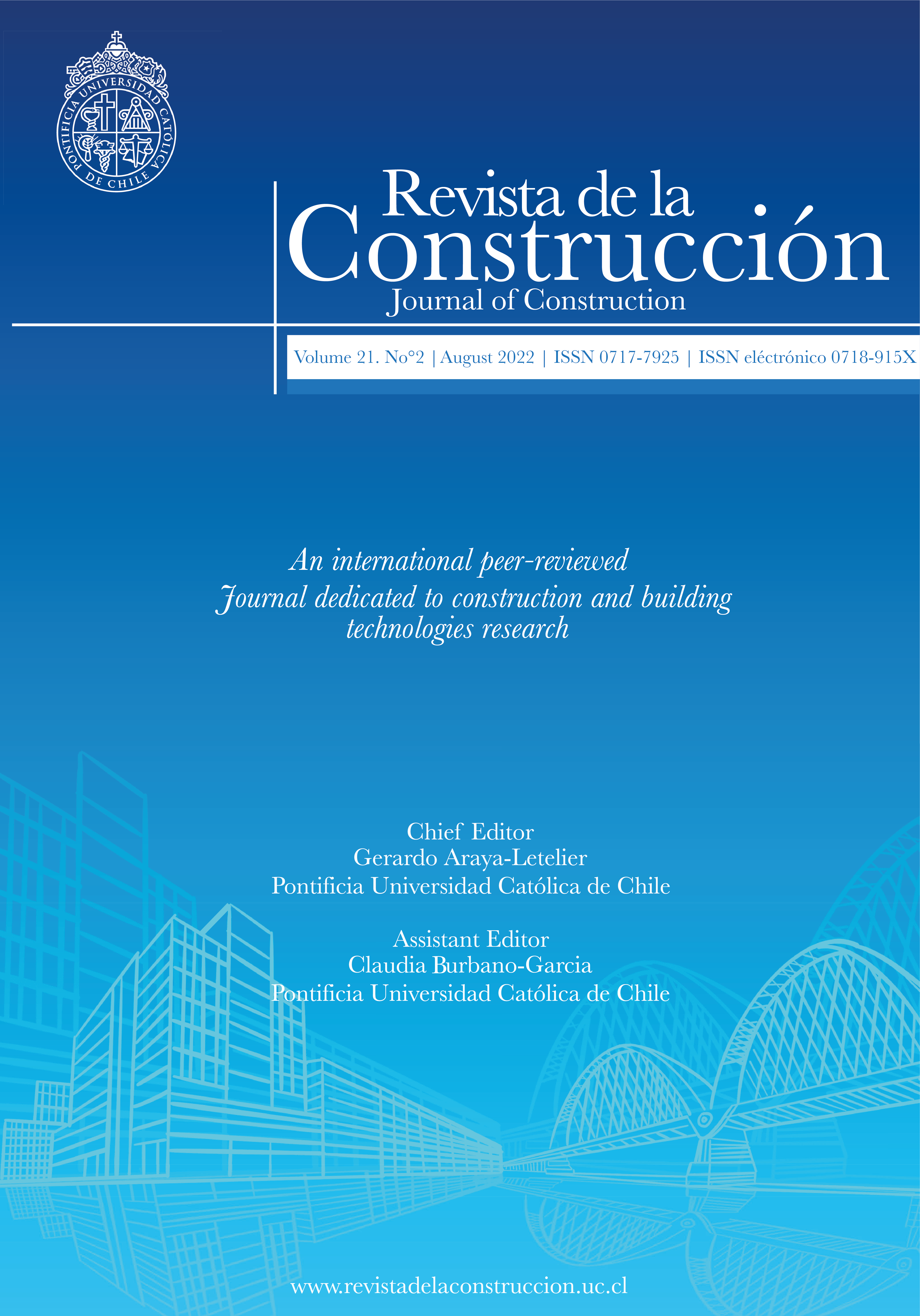Numerical modelling of concrete tunnels exposed to rock fall
DOI:
https://doi.org/10.7764/RDLC.21.2.215Keywords:
Concrete tubes, finite elements, numerical analysis, rock crashing, impact energy.Abstract
Tunnel entrances are among the most likely places for rock fall events. For this reason, concrete tubes are constructed before tunnel entrances against rock falls. In this study, the normal stress and the deformation in both horizontal and vertical directions occurred by crashing rock on concrete tunnel tubes were investigated using finite element method in three dimensional conditions. Different velocities and masses of falling rock analyzed to demonstrate effect of velocity on normal stress and deformations. It was observed that deformations on the concrete tube increased as the impact energy increased due to increasing velocity and mass. The mass of crashed rock, M, is changes from 3 kN to 200 kN and peak deformations could reach approximately 150 cm when the mass of falling rock was M=200 kN and V = 30 m/s. When the velocity of rock V=10 m/s just before the impact, the ratios of deformations to rock mass of 3 kN, 25 kN, and 200 kN were approximately 0.00066 m/kN, 0.0014 m/kN and 0.00175 m/kN, respectively.
References
Altay, G. (2015). Numerical Investigation of Embankments Used for Rockfall Protection (Master's thesis, Department of Civil Engineering, Osmaniye Korkut Ata University).
Altay, G. and Kayadelen, C. (2015) Numerical Investigation of Embankments for Protecting Rockfall. 17th International Conference on Geotechnical Engineering, (ICGE), Rome-ITALY, pp. 1033-1038.
Bin Yu, Wei Yi and Huaibao Zhao. Experimental study on the maximum impact force by rock fall. Landslides (2018) 15:233–242. DOI 10.1007/s10346-017-0876-x.
Buckingham E. (1915). Model experiments and the form of empirical equations: Am. Soc. Mech. Eng., Trans., v. 37, p. 263–296
Calvetti F., Prisco C., Vecchiotti M. (2005). Experimental and numerical study of rock-fall impacts on granular soils, RIVISTA ITALIANA DI GE-OTECNICA 4/2005
Chen X., Wu Y., Yu Y., Liu J., Xu X.F., Ren J. (2014). A two-grid search scheme for large-scale 3-D finite element analyses of slope stability. Computers and Geotechnics 62: 203–215.
Compilation by Japan Road Association. Handbook for rock fall measures; 2000. p. 20–3 [in Japanese]
Grassl H., Volkwein A., Bartelt P., (2002). Experimental and Numerical Modeling of Highly Flexible Rockfall Protection Barriers. Swiss Federal Institute of Snow and Avalanche Research SLF.
Hu J., Li S., Li L., Shi S., Zhou Z., Liu H. and He P. Field, experimental, and numerical investigation of a rockfall above a tunnel portal in southwestern China. Bull. Eng. Geol. Environ. (2018) 77:1365–1382.
L. M. Chu and L. M. Zhang. Centrifuge Modeling of Ship Impact Stresses on Bridge Pile Foundations. Journal of Geotechnical and Geoenvironmental Engineering, Vol. 137, No. 4, April 1, 2011. ©ASCE, ISSN 1090-0241/2011/4-405–420.
Labiouse V., Descoeudres F., Montani S. (1966).. Experimental Study of Rock Sheds Impacted by Rock Blocks [J]. Structural Engineering International, 3(1): 171-175.
Mishra, S., Zaid, M., Rao, K. S., & Gupta, N. K. (2021). FEA of Urban Rock Tunnels Under Impact Loading at Targeted Velocity. Geotechnical and Geological Engineering, 1-19.
Pichler B., Hellmich C., Mang H.A. (2005). Impact of rocks onto gravel design and evaluation of experiments. Int. J. Impact Eng. 31(5):559–578.
Sadique, M., Zaid, M., & Alam, M. (2022). Rock tunnel performance under blast loading through finite element analysis. Geotechnical and Geological Engineering, 40(1), 35-56.
Shi G.H. and Goodman R.E. (1985). Two dimensional discontinuous deformation analysis. Int. J. Numer. Anal. Meth. Geomech.; 9:541–56.
Terzaghi K. (1950). Mechanisms of landslides, Engineering Geology (Berdey) volume. Geological Society of America.
Wang D.P., He S.M., Li X.P., Xiang B. (2012). Study on the dissipating effects of shed with EPS cushion under impact stress. J. Sichuan Univ. Eng. Sci. Ed 44(6):102–107.
Zaid, M., Sadique, M., & Samanta, M. (2020). Effect of unconfined compressive strength of rock on dynamic response of shallow unlined tunnel. SN Applied Sciences, 2(12), 1-13.
Zaid, M. (2021a). Dynamic stability analysis of rock tunnels subjected to impact loading with varying UCS. Geomechanics and Engineering, 24(6), 505-518.
Zaid, M. (2021b). Preliminary Study to Understand the Effect of Impact Loading and Rock Weathering in Tunnel Constructed in Quartzite. Geotechnical and Geological Engineering, 1-29.
Zaid, M. (2021c). Three-dimensional finite element analysis of urban rock tunnel under static loading condition: effect of the rock weathering. Geomechan-ics and Engineering, 25(2), 99-109.
Zaid, M., Sadique, M., & Alam, M. (2022). Blast Resistant Analysis of Rock Tunnel Using Abaqus: Effect of Weathering. Geotechnical and Geological Engineering, 1-24.
Zaid, M., & Shah, I. A. (2021). Numerical analysis of himalayan rock tunnels under static and blast loading. Geotechnical and Geological Engineering, 39(7), 5063-5083.
Downloads
Published
Versions
- 2022-08-31 (4)
- 2022-08-31 (3)
- 2022-08-31 (2)
- 2022-08-31 (1)
How to Cite
Issue
Section
License
Copyright (c) 2022 Baki Bağrıaçık, Gökhan Altay, Suat Önal, Cafer Kayadelen

This work is licensed under a Creative Commons Attribution-NonCommercial-NoDerivatives 4.0 International License.





